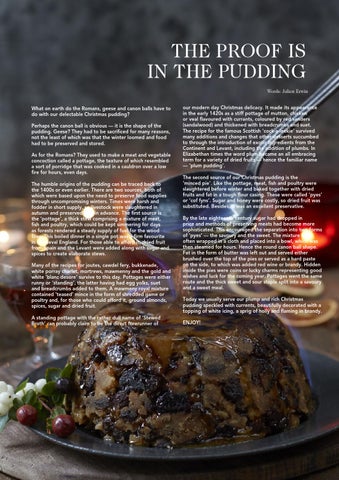THE PROOF IS IN THE PUDDING Words: Julien Erwin
What on earth do the Romans, geese and canon balls have to do with our delectable Christmas pudding? Perhaps the canon ball is obvious — it is the shape of the pudding. Geese? They had to be sacrificed for many reasons, not the least of which was that the winter loomed and food had to be preserved and stored. As for the Romans? They used to make a meat and vegetable concoction called a pottage, the texture of which resembled a sort of porridge that was cooked in a cauldron over a low fire for hours, even days. The humble origins of the pudding can be traced back to the 1400s or even earlier. There are two sources, both of which were based upon the need to preserve food supplies through uncompromising winters. Times were harsh and fodder in short supply, so livestock were slaughtered in autumn and preserved well in advance. The first source is the ‘pottage’, a thick stew comprising a mixture of meat, fish and poultry, which could be kept simmering for days as forests rendered a steady supply of fuel for the wood fires. This boiled dinner in a single pot was a firm favourite in Medieval England. For those able to afford it, dried fruit from Spain and the Levant were added along with sugar and spices to create elaborate stews. Many of the recipes for joutes, cawdel fery, bukkenade, white porray charlet, mortrews, mawmenny and the gold and white ‘blanc desore’ survive to this day. Pottages were either runny or ‘standing’, the latter having had egg yolks, suet and breadcrumbs added to them. A mawmeny royal mixture contained ‘teased’ mince in the form of shredded game or poultry and, for those who could afford it, ground almonds, spices, sugar and dried fruit. A standing pottage with the rather dull name of ‘Stewed Broth’ can probably claim to be the direct forerunner of
our modern day Christmas delicacy. It made its appearance in the early 1420s as a stiff pottage of mutton, chicken or veal flavoured with currants, coloured by red sanders (sandalwood) and thickened with breadcrumbs and suet. The recipe for the famous Scottish ‘cock-a-leekie’ survived many additions and changes that other desserts succumbed to through the introduction of exotic ingredients from the Continent and Levant, including the addition of plumbs. In Elizabethan times the word plum became an all embracing term for a variety of dried fruits — hence the familiar name — ‘plum pudding’. The second source of our Christmas pudding is the ‘minced pie’. Like the pottage, meat, fish and poultry were slaughtered before winter and baked together with dried fruits and fat in a tough flour casing. These were called ‘pyes’ or ‘cof fyns’. Sugar and honey were costly, so dried fruit was substituted. Besides, it was an excellent preservative. By the late eighteenth century sugar had dropped in price and methods of preserving meats had become more sophisticated. This encouraged the separation into two forms of ‘pyes’ — the savoury and the sweet. The mixture was often wrapped in a cloth and placed into a bowl, which was then steamed for hours. Hence the round canon ball shape. Fat in the form of butter was left out and served either brushed over the top of the pies or served as a hard paste on the side, to which was added red wine or brandy. Hidden inside the pies were coins or lucky charms representing good wishes and luck for the coming year. Pottages went the same route and the thick sweet and sour staple split into a savoury and a sweet meal. Today we usually serve our plump and rich Christmas pudding speckled with currents, beautifully decorated with a topping of white icing, a sprig of holly and flaming in brandy. ENJOY!
— VERVE DECEMBER 2014 // 97
